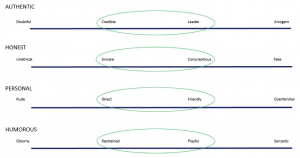One way we write compelling ORIO content is by being aware of our voice and our tone. This section explains the difference between voice and tone, and lays out the elements of each as they apply to Total Synergy.
What’s the difference between voice and tone? Think of it this way: You have the same voice all the time, but your tone changes. You might use one tone when you’re out to dinner with your closest friends, and a different tone when you’re in a meeting with your boss.
Your tone also changes depending on the emotional state of the person you’re addressing. You wouldn’t want to use the same tone of voice with someone who’s scared or upset as you would with someone who’s laughing.
The same is true for Total Synergy. Our voice doesn’t change much from day to day, but our tone changes all the time.
Voice
Synergy’s voice is human. It’s authentic, honest, personal and humorous. Our priority is helping our users get their work done so they can get on with their lives (aka more time for design). We want to communicate our messages through content that reflects who we are, and respects who they are.
One way to think of our voice is to look at scales of word types aligned with authentic, honest, personal and humorous — these words can all go too far in either direction, we want to hit the sweet zones:

Tone
Total Synergy’s tone is usually informal and relaxed, but it’s always more important to be clear than entertaining. When you’re writing, consider the reader’s state of mind. Are they appreciative of the application (are they actually finding more time for design)? Are they confused and seeking our help on Twitter or through the help desk? Are they curious about a post on our blog? Once you have an idea of their emotional state, you can adjust your tone accordingly.
Style tips
Here are a few key elements of writing Total Synergy’s voice. For more, see the grammar and mechanics section.
- Use active voice. Avoid passive voice.
- Avoid slang and jargon. Write in plain English.
- Use positive language rather than negative language.
A note about Wingman
Wingman is the characterisation of Synergy — Wingman’s got your back in the business of designing the built environment.
Wingman was created as the first brand campaign for Synergy v5. Wingman is informally named Ric after our values (respect, integrity, care). Wingman is not gender specific — anyone can be a wingman — he just began life as a he. Wingman doesn’t speak (so don’t write in his voice), he’s just there; he’s got your back.